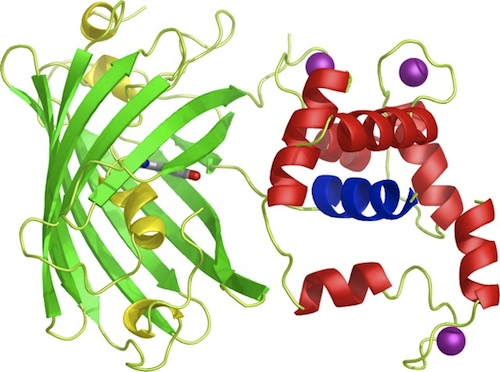GECOs – New proteins for calcium imaging
Post by Christian Wilms
Call me old-fashioned, but I’m a big fan of small organic calcium indicators (e.g., Oregon Green BAPTA 1). Yes, genetically encoded calcium indicators (GECIs) have many advantages: targeting to specific cell populations, subcellular targeting, etc. But for quantitative, high SNR work, OGB-1 & Co. (ideally not as an AM-ester) is where it’s at.
There are several reasons for this: GECIs have fairly small signal amplitudes (commonly on the level of under 10-fold fluorescence increase from calcium free to calcium bound). They are slow, with on- and off-rates several orders of magnitude slower than BAPTA-based indicators. They are only available in two overlapping hues (green or blue/yellow) limiting the combinability with other indicators and dyes. Finally, the link between [Ca2+] and GECI fluorescence is very non-linear, making quantification difficult.
Not that there hasn’t been any progress over the past decade: the fluorescence increase on calcium binding has steadily increased over the years, the introduction of troponin-C in place of calmodulin as a binding domain has caused a mild increase in kinetics and there have been some preliminary presentations of spectrally shifted GECIs. But all in all, a big jump ahead has not happened yet.
That was the situation until two weeks ago, when Rob Campbell’s lab published an exciting report: Using a bacteria-based high throughput screen, they scanned tens of thousands of randomly generated mutations of GCaMP3. Using this approach they developed a series of GECOs (for Genetically Encoded Calcium indicators for Optical imaging). Among this series is a green fluorescing indicator (G-GECO) with a 26-fold intensity change on binding calcium, a red indicator (R-GECO) with a 16-fold change and a blue indicator (you guessed it: B-GECO) with a more humble 4-fold increase. In addition they developed an emission ratiometric indicator (GEM-GECO) with a flabbergasting 110-fold ratio change as well as an excitation ratiometric indicator (GEX-GECO) with a 26-fold change in ratio.
While the kinetics are still in the same range as those of previous GECIs, the combination of different spectral variants and large dynamic range does address to major limitations of earlier GECIs. Finally, to make a good thing better, the authors will be making all the GECIs open to public access by depositing them at addgene.org.

Correction: Dr. Campbell’s name is Rob (Robert), not Roger.
Unfortunately, it seems that GECOs do not show any improved performance over GCaMP3 in mammalian neurons, when characterized with electrophysiology in acute brain slices.
http://www.frontiersin.org/cellular_neuroscience/10.3389/fncel.2012.00041/abstract